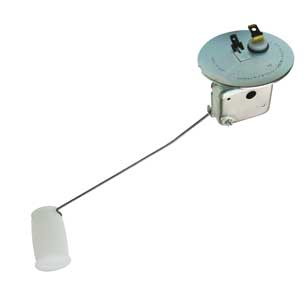
The Fuel Gauge
The Fuel Gauge comprises of only three parts, the gauge itself on the dashboard, a voltage regulator (usually behind the dashboard on the speedometer) and the sender on the top of the fuel tank which look like this:

How does it work? The Sendor consists of a float, connected to a thin, metal rod. The end of the rod is mounted to a variable resistor ( an electrical device that resists the flow of electricity). The more resistance there is, the less current will flow. The more current flows, the more the needle in the gauge will be deflected to the top of the scale.
In the fuel tank, the variable resistor consists of a strip of resistive material connected on one side to the ground. A wiper connected to the gauge slides along this strip of material, conducting the current from the gauge to the resistor. If the wiper is close to the grounded side of the strip, there is less resistive material in the path of the current, so the resistance is small. If the wiper is at the other end of the strip, there is more resistive material in the current's path, so the resistance is large. When the tank is full, the float is at the top of the tank and the resistance is small and therefore the current flowing is large. This pushes the needle in the gauge to the top of the scale indicating 'full'. When the tank is empty the float is at the bottom and the resistance is large - then the needle in the gauge is at the bottom of its travel indicating 'empty"
![]()